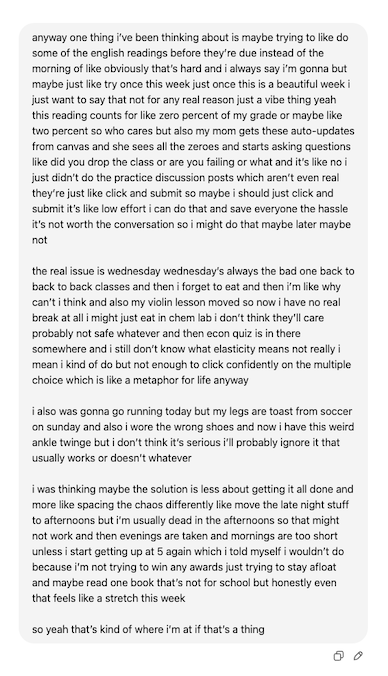Forget Prompt Engineering: Just Start Talking
People love to talk and write articles about the importance of “prompt engineering” with large language models. You’ve probably seen some version of this idea floating around:
If you're building apps, writing code, or trying to push the limits of what an LLM can do, then yes, prompt engineering can matter quite a bit.
But if you’ve got an ADHD brain (or you're working with someone who does) - it’s perhaps a bit intimidating. Wait, now I need to know how to ask this thing a question in just the right way? And I’m here to say:
No, You Don’t. Just Say Stuff!
The bottleneck for the ADHD mind is often cognitive overload and working memory strain. And in that context, you don’t want to impose constraints on someone’s thinking process. You want them to empty their mind!
LLMs can be perfect for this. Our clients who utilize this do it best when spoken. Don’t even worry about typing anything. Make it unedited, messy. blurted.
It’s as simple as opening an LLM, turn on the voice feature, and talking. Pacing your kitchen, walking the block, whatever. Say “like” a hundred times. Change topics mid-sentence, stress about those texts you forgot to reply to, loop back to your bloodwork results, and realize you haven’t returned your library books. Let it all out. Here’s an anonymized student’s version of that:
He wasn’t trying to prioritize. He was just getting things off his mind. What he’s doing is an unfiltered capture, a riff on David Allen’s GTD process. As Allen always reminds us - your head is a terrible office. Don’t keep too much in there.
LLMs are unusual conversational partners - they can “follow the thread,'“ even if there isn’t a thread.
There are no interruptions, no judgment, and limited forgetting. Just talk for five, six, even ten minutes. You can then stop talking. Or ask it to summarize. It doesn't matter.
What comes back is almost always clearer than what you thought you said. That’s the point. LLMs paraphrase, cluster, organize, "bullet-point." People make fun of them for this. But they’re really good at it, and it can be quite useful! Consider what our client got back from his riff above:
And that’s why this works in a way that even the best human listener often can’t replicate. Most people, no matter how smart or supportive, can’t track twelve unfinished ideas bouncing across five domains across 400 seconds of speaking. But the model can. It doesn’t get tired, and it doesn’t judge.
You’re not asking it to do your thinking for you: you’re asking it to reflect your thinking back to you in a form you can finally see.
It’s also why you have to resist the urge to edit while you talk. That’s one of the traps! Filtering in real time, evaluating every sentence, trying to present a coherent thought instead of just getting it out. This isn’t a performance. It’s a brain-dump. There’s no such thing as “too long” or “too messy.” There’s only: did you say what’s actually on your mind?
Next time you’re spinning, try this: hit voice, ramble until you feel done, and ask for a summary or a checklist or prioritized list. You might be surprised at how much lighter you feel after.
***
I think Hamlet is the greatest “blurter'“ of all time. As Harold Bloom writes:
All that matters is Hamlet's consciousness of his own consciousness, infinite, unlimited, and at war with itself.
I sometimes wonder what Hamlet would have been like with an LLM. Infinite and unlimited!




